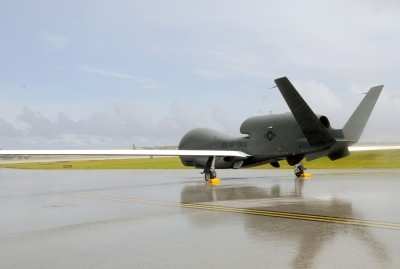Sun, Mar 20, 2011
Provides Wide View Of Situation On The Ground, Real-Time
Information
Pacific Air Forces officials are using an RQ-4 Global Hawk from
Andersen Air Force Base, Guam, to assist Japanese responders in
disaster relief and recovery efforts, following the March 11
earthquake and the resulting tsunami off the eastern coast of
Japan. The Global Hawk, a high-altitude, long-endurance unmanned
aircraft, is being used to help assess damage to towns, industrial
infrastructure and other facilities affected during the earthquake
and flood waters.

"The Global Hawk is an ideal ISR asset to aid in disaster
relief," said Gen. Gary North, the PACAF commander. "It directly
complements ongoing efforts in the region and represents how
advanced technology can provide crucial and timely support to
senior officials and search, recovery and disaster relief
efforts."
The Global Hawk also was used for disaster relief efforts
following the 7.0-magnitude earthquake that struck Haiti in January
2010, officials said. This will be the aircraft's first use in a
humanitarian operation in the Pacific theater since it was
permanently assigned at Andersen AFB in September 2010.
With approximately 30 hours of flight endurance, the Global Hawk
provides a broad view of the situation on the ground, officials
said. Its ability to survey large geographic areas also offers
decision-makers and first responders near real-time information to
assess damage and prioritize for local need. Its long airborne
dwell capacity also assures continuous and long-lasting-support for
whatever requirements Japan's government officials may require.
"The Global Hawk and the expertise offered by our Airmen further
enhances the country's already robust capabilities as our Air force
members work side by side with Japan's Self Defense Force
professionals," General North said.
The aircraft allows the U.S. to effectively support
contingencies throughout the region, demonstrating a commitment to
partners throughout the Pacific, and is one part of a wide range of
PACAF personnel and aircraft that are supporting the Japanese
operations, officials said.
More News
Known Traffic With respect to ATC clearances, means aircraft whose altitude, position, and intentions are known to ATC.>[...]
Aero Linx: Aviation Suppliers Association (ASA) Established February 25, 1993, the Aviation Suppliers Association (ASA), based in Washington, D.C., is a not-for-profit association,>[...]
Abeam An aircraft is “abeam” a fix, point, or object when that fix, point, or object is approximately 90 degrees to the right or left of the aircraft track. Abeam indic>[...]
Aero Linx: The Air Charter Safety Alliance The group, called the Air Charter Safety Alliance, will raise awareness of illegal charter flights among potential customers, charter bro>[...]
“For months, ALPA has been sounding the alarm on the ongoing efforts by some aircraft manufacturers to remove pilots from the flight deck and replace them with automation. To>[...]
 ANN's Daily Aero-Term (06.10.24): Known Traffic
ANN's Daily Aero-Term (06.10.24): Known Traffic ANN's Daily Aero-Linx (06.10.24)
ANN's Daily Aero-Linx (06.10.24) ANN's Daily Aero-Term (06.11.24): Abeam
ANN's Daily Aero-Term (06.11.24): Abeam ANN's Daily Aero-Linx (06.11.24)
ANN's Daily Aero-Linx (06.11.24) Aero-News: Quote of the Day (06.11.24)
Aero-News: Quote of the Day (06.11.24)



